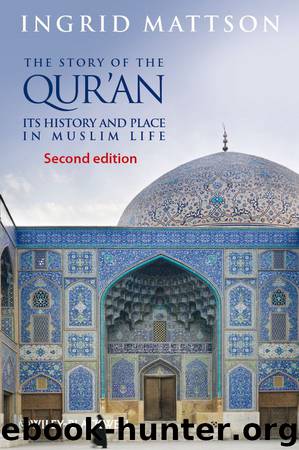The Story of the Qur'an by Ingrid Mattson

Author:Ingrid Mattson
Language: eng
Format: epub
Publisher: Wiley
Published: 2012-12-05T16:00:00+00:00
The Qur’an and Sacred Architecture
Theological controversies aside, Muslims are united in the belief that the Qur’an is the word of the Divine. In whatever sense they have understood this phrase, Muslims have been in agreement that the Qur’an has a unique ontological status. It is for this reason that Muslim societies are infused with the sound and script of the Qur’an. Oral and written tradition support and complement each other to allow God’s word to reach the heart of every believer.
It is said that in pre-Islamic Arabia, the master poems, the Mu῾allaqat, were recited in the market of ‘Ukaz and hung on the Ka‘ba. After the rise of Islam, God’s words were recited day and night in the sanctuary of Mecca, and the Ka‘ba was draped in cloth embroidered with Qur’anic verses.7 Across the centuries, as Semitic, European, Asian, and African peoples embraced Islam, their soundscapes and landscapes too were transformed with the words of the Qur’an. Qur’anic recitation fills the air of Muslim societies as schoolchildren repeat verses after their teachers, loudspeakers broadcast morning and evening prayers from the mosques, groups gather to recite Qur’an upon the death anniversary of relatives, and shopkeepers play recitations of famous Qaris (“Reciters”) for their customers.
On the visual plane, Qur’anic verses rendered by hand in elegant calligraphy and masterful engraving decorate mosques and homes; elsewhere, verses printed on mass-produced calendars and kitschy wall-clocks are displayed. Everywhere, the protective, blessed, and talismanic presence of the Word of God is experienced.8
By the time Islam established a presence in Europe and Asia, most major religious traditions already present on these two continents (excluding Judaism) invoked the sacred with images, although many of these traditions, including Christianity and Buddhism, had passed through significant periods of aniconism or iconoclasm.9 Islam’s rejection of figurative religious art can be traced to the Prophet Muhammad’s destruction of the idols housed in the Ka‘ba. When Mecca surrendered to the Prophet in 8/630, the inhabitants of the city agreed to embrace Islam and Muhammad as their spiritual and political leader. On the basis of this authority, Muhammad cleansed the Ka‘ba of the idols, just as his ancestor Abraham had destroyed the idols of his people. Abraham had prayed that his descendants would never again resort to idol worship (14:35; 21:55–67); despite his prayer, the Quraysh had allowed the Ka‘ba to become a house of idols. Perhaps this furthered their economic goals, for allowing merchants a space in the Ka‘ba for their idols may have helped Mecca become an important center of commerce. We might find in Muhammad’s destruction of the idols echoes of Jesus’ forceful action in clearing the temple of the moneychangers.
Because the Ka‘ba occupies a unique position in Islamic spirituality and worship as the place of pilgrimage and the direction of prayer, it is the Prophet’s mosque at Medina that provides the basic model for all other mosques. Thus, all later mosques have an open, roughly rectangular prayer hall with some indication of the direction of the Ka‘ba (the qibla) in the wall.
Download
This site does not store any files on its server. We only index and link to content provided by other sites. Please contact the content providers to delete copyright contents if any and email us, we'll remove relevant links or contents immediately.
| Hadith | History |
| Law | Mecca |
| Muhammed | Quran |
| Rituals & Practice | Shi'ism |
| Sufism | Sunnism |
| Theology | Women in Islam |
The History of Jihad: From Muhammad to ISIS by Spencer Robert(2574)
Nine Parts of Desire by Geraldine Brooks(2328)
The Turkish Psychedelic Explosion by Daniel Spicer(2314)
The First Muslim The Story of Muhammad by Lesley Hazleton(2219)
The Essential Rumi by Coleman Barks(1992)
1453 by Roger Crowley(1971)
The Last Mughal by William Dalrymple(1831)
Trickster Travels: A Sixteenth-Century Muslim Between Worlds by Davis Natalie Zemon(1815)
God by Aslan Reza(1615)
Muhammad: His Life Based on the Earliest Sources by Martin Lings(1608)
by Christianity & Islam(1596)
A Concise History of Sunnis and Shi'is by John McHugo(1547)
Magic and Divination in Early Islam by Emilie Savage-Smith;(1501)
No God But God by Reza Aslan(1495)
The Flight of the Intellectuals by Berman Paul(1466)
Art of Betrayal by Gordon Corera(1403)
Nothing to Envy by Barbara Demick(1388)
What the Qur'an Meant by Garry Wills(1363)
Getting Jesus Right: How Muslims Get Jesus and Islam Wrong by James A Beverley & Craig A Evans(1312)
